18 Feb, 2025 | Admin | No Comments
Mogau Kekana South African Animator, Storyboard and Character Artist
Mogau Kekana is a South African illustrator, animator, and film director hailing from Hillbrow, Johannesburg. His artistic journey began in primary school and continued through university, where he honed his skills in digital art and animation. Kekana’s work focuses on creating proud, authentic representations of African culture. He has been involved in various projects, including […]
12 Feb, 2025 | Admin | No Comments
Iyanu: Child of Wonder : Nigerian Animation Bringing Yoruba Mythology to Life
https://www.youtube.com/watch?v=c0BgMxgAcJ4 The animated landscape is about to witness a groundbreaking addition with Iyanu: Child of Wonder, an upcoming children’s animated series adapted from the acclaimed Dark Horse Comics/YouNeek Studios graphic novel series. HBO Max, Cartoon Network, and Lion Forge Animation have joined forces to bring this epic superhero tale, rooted in Nigeria’s rich culture, music, […]
Shower curtains are frequently one of the most noticeable and useful features of the bathroom. As a result, you should carefully consider the size and type that will be most effective in your space.
When selecting a shower curtain, size and type are key factors, ensuring that your shower curtain fits and meets your needs. Standard shower curtain sizes are suitable for most tubs and shower stalls, providing adequate coverage to keep water where it belongs. The type of shower curtain also plays a role in the functionality of the bathroom. Each has different levels of durability, maintenance, and aesthetic appeal. Understanding the common dimensions and types will allow you to choose a shower curtain that best meets your needs.
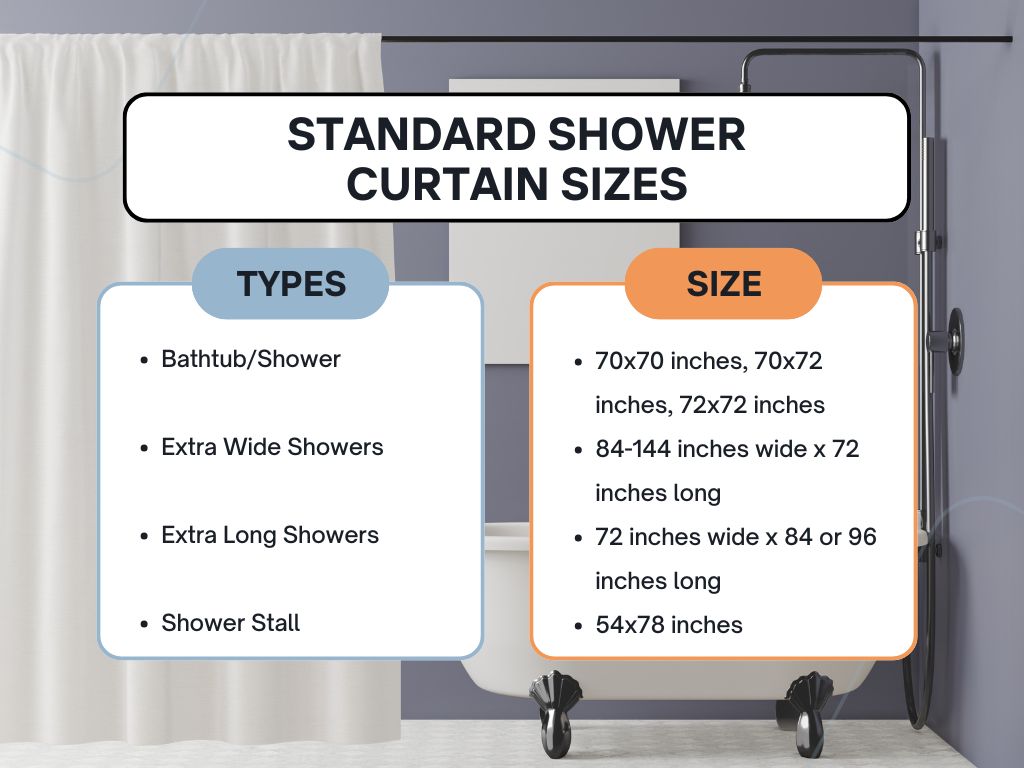
Standard Shower Curtain Sizes
Standard curtain sizes differ slightly because shower sizes vary depending on if your shower is a standalone stall or a shower/tub combination. These sizes may vary, but they are all readily available sizes rather than custom sizes that require special ordering.
- Bathtub/Shower Combination: 70×70 inches, 70×72 inches, 72×72 inches—These are the most widely used sizes, designed to fit a standard bathtub with a straight curtain rod.
- Extra Wide Showers: 84-144 inches wide x 72 inches long—Ideal for larger tubs like clawfoot, where you need the curtain to wrap around the tub, or for bathtubs with curved rods.
- Extra Long Showers: 72 inches wide x 84 or 96 inches long—Designed for showers in rooms with tall ceilings or tall shower enclosures.
- Shower Stall: 54×78 inches
How to Measure for the Right Fit
To find the right shower curtain size, start by measuring the width of your shower area. Measure from wall to wall or measure the width of your shower curtain rod. Add twelve inches to this measurement to ensure that your curtain has the proper fullness when pulled from edge to edge. Opt for an extra-wide shower curtain if your rod is curved.
For the height, measure from the shower rod to the bottom edge of the tub or just above the floor, depending on the look you want. Shower curtains typically hang about an inch above the floor. You can also adjust the height of your shower rod to adjust the height of the curtain.
Types of Shower Curtains
Shower curtains are available in a wide range of materials and styles that each come with benefits and drawbacks to consider.
Materials
There are two main types of materials that are used to make shower curtains: natural and synthetic. Some people want the organic look of natural fiber, which adds a greater textural element to the bathroom. Others prefer the functionality and easy maintenance of synthetic curtains.
Cotton
Cotton is a natural fiber that is soft and breathable. It is a durable but cost-effective fabric that can add a luxe but comfortable and organic look to your bathroom. Cotton shower curtains are easy to clean because they are machine washable. They may require ironing to remove any residual wrinkles, depending on the weave. Prone to mold and mildew, cotton shower curtains will require the use of a waterproof liner.
Linen
Linen is a natural, textured fabric of medium weight that is known for its organic appearance and quick drying properties. It is both aesthetically pleasing and environmentally friendly. Linen fabric is simple to wash, but like cotton, it may need to be ironed afterward to restore its smoothness. Linen can absorb water well, but it is not waterproof. Linen shower curtains require a separate liner.
Polyester
Polyester is a synthetic fabric that is known for its durability and ease of maintenance. Polyester shower curtains are often less expensive than natural fabric options, but they do not have the same depth of texture and interest. Other benefits include a quick drying time, the ability to retain colors and patterns without fading, and mildew resistance. While polyester curtains are water resistant, they are not waterproof, so most require an additional shower liner.
Vinyl
Vinyl shower curtains are designed to be used without an additional shower liner, making them the most practical option among the available options. Vinyl is a completely waterproof and long-lasting material. Vinyl shower curtains can be ripped if they come into contact with sharp objects. Vinyl contains harmful chemicals and can have a strong odor when it is new. Curtains made from vinyl are the most economical because they do not require the purchase of a liner.
Nylon
Nylon, which is lightweight and synthetic, is another option for those looking for something lighter than vinyl but less maintenance-intensive than natural fabrics. Nylon is a water-resistant material that dries quickly. It is mildew resistant but may stain with prolonged exposure. Nylon shower curtains are machine-washable.
Blended Fabrics
Blended fabrics combine the aesthetic appeal of natural fabrics with the durability and ease of care of synthetics. Most blended fabrics for shower curtains contain either cotton or linen mixed with polyester. These curtains are partially water-resistant due to the addition of polyester, but they can be treated with a back coating to make them even more waterproof.

Design Variations
Shower curtain design options include the appearance and feel of the curtains, as well as how they fit and function in your shower.
Patterned vs Solid
When you go to buy a shower curtain, you will be confronted with a wide range of color and pattern options. Solid-colored curtains are the simplest and most understated option. These are suitable for a variety of styles, from contemporary to traditional. Lighter-colored curtains make a bathroom feel more spacious and airy, whereas darker tones add depth and sophistication.
Patterned shower curtains can introduce personality and interest and quickly dominate the small space of a bathroom. Geometric shapes, florals, stripes, and abstract prints serve as a focal point from which you can take color cues to use in other parts of the bathroom.
Textured vs Smooth
The weave of the fabric has a significant impact on the appearance and functionality of the shower curtain. Textured fabrics add depth and dimension, with options such as waffled-weave, ribbed, embroidered, and ruffles to make the curtain more decorative. Textured fabrics can also help to hide discoloration and soap residue while increasing water absorption, making them easier to maintain in the long run.
Smooth-surfaced shower curtains look minimal and sleek, giving them a modern appearance. Smooth surfaces do show more wear, but depending on the fabric, are easier to clean and iron than textured fabrics.
Weighted or Unweighted Bottom
A weighted or unweighted bottom differs in terms of functionality and appearance. A weighted bottom has small metal or plastic weights sewn into the bottom hem. This helps to keep the shower curtain in place and prevents it from billowing inwards while you shower. While weights do hold the shower curtain in place, they can also catch higher on the tub and make the shower curtain hang awkwardly.
An unweighted bottom has no additional support, so it might blow in during showers and allow water to leak through. These curtains are lighter-weight and flexible, but they may require more frequent adjustments.
Grommet, Buttonhole, or Hookless Curtains
Grommets are a popular attachment style for shower curtains. These curtains feature metal rings at the top of the curtain that you use with curtain hooks. These make the ring hole durable and strong. For a less oververt opening style, consider a buttonhole top. These curtains feature reinforced buttonholes that you can use with curtain rings.
Hookless curtains eliminate the need for curtain rings and attach using either a rod pocket sewn into the top of the curtain or large grommets that can be threaded directly onto the curtain rod.
How to Choose the Right Shower Curtain
Selecting the right shower curtain for you requires considering the following elements:
- Size and Fit: Ensure that the shower curtain is long and wide enough for your shower while allowing ample space to drape gracefully.
- Water Resistance and Care: Consider who is using the shower when determining your curtain fabric. For high-humidity or high-traffic, kid-friendly bathrooms, opt for water-resistant and easy-care fabrics. For adult, older children, or infrequently used bathrooms, you can opt for a curtain that is higher maintenance if desired.
- Aesthetics and Style: Keep in mind that a heavily patterned or brightly colored curtain will dictate the appearance of the bathroom. If you are unsure of your desired style or want more design flexibility, go with a light-colored solid or lightly patterned curtain.
- Durability: High-quality materials and reinforcing features like a grommet top will increase the longevity of your shower curtain.
The post Standard Shower Curtain Sizes and Types appeared first on Homedit.
Stone walls in a bathroom are unexpected, making them an excellent choice for creating a unique look. Stone also adds organic elegance and rich texture to any interior. The tactile properties and earthy colors of stone create a sense of warmth and tranquillity, transforming your bathroom into a spa-like retreat. Stone can be used to add depth to a variety of interior styles, from modern to traditional, but beyond its visual appeal, natural stone’s durability makes it the ideal combination of style and substance.
Natural materials in the bathroom are an excellent way to create a space that is both earthy and luxurious. Consider the various ways that designers have incorporated stone walls into bathrooms to create distinctive looks. We have gathered examples of bathrooms with diverse designs so that you can see the broad ways you can use stone walls in the bathroom.
Mediterranean Style Bathroom
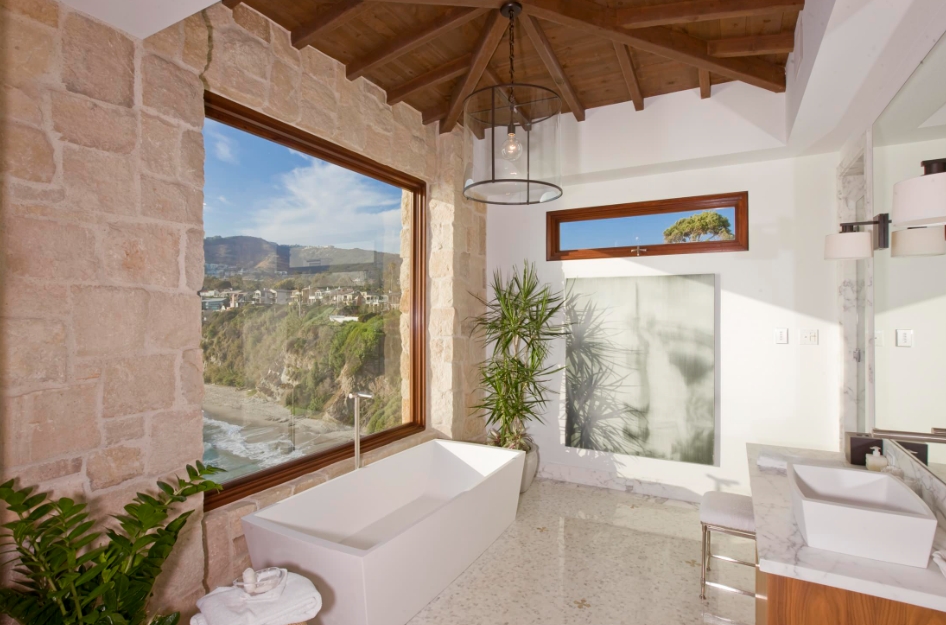
The contrast between the stone wall and the clean, white surrounding walls is striking in this bathroom. While the contrast is distinctive, the designers chose to soften the differences by using light grout that blends with the walls and the other light colors in the floors and counter surfaces.
The stone adds warmth and depth to the bathroom, giving it the look and timeless appeal of a Mediterranean retreat. Its uneven surface and irregular shape add a hint of rusticity to this otherwise modern bathroom.
Log Cabin Bathroom
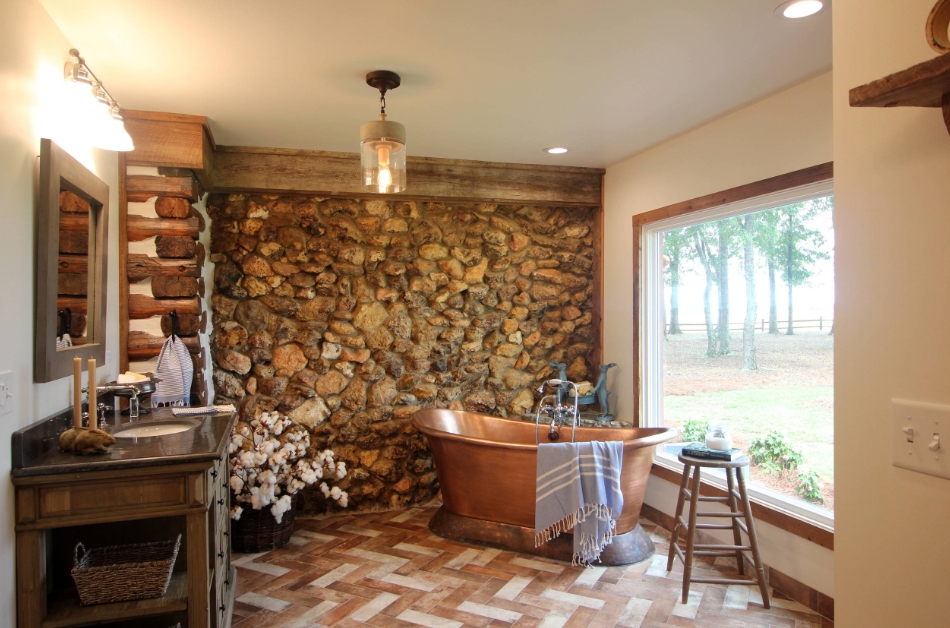
The stone wall in this master bathroom was an exterior wall before an extensive renovation made it part of the interior bathroom. Rather than work against the stone, the designer incorporated the colors and texture of the stone into the design. They echoed the earthy colors into the herringbone brick floor and copper bathtub. The large, plate glass window and the warm white walls help to keep the bathroom feeling light and bright.
Lake House Bathroom
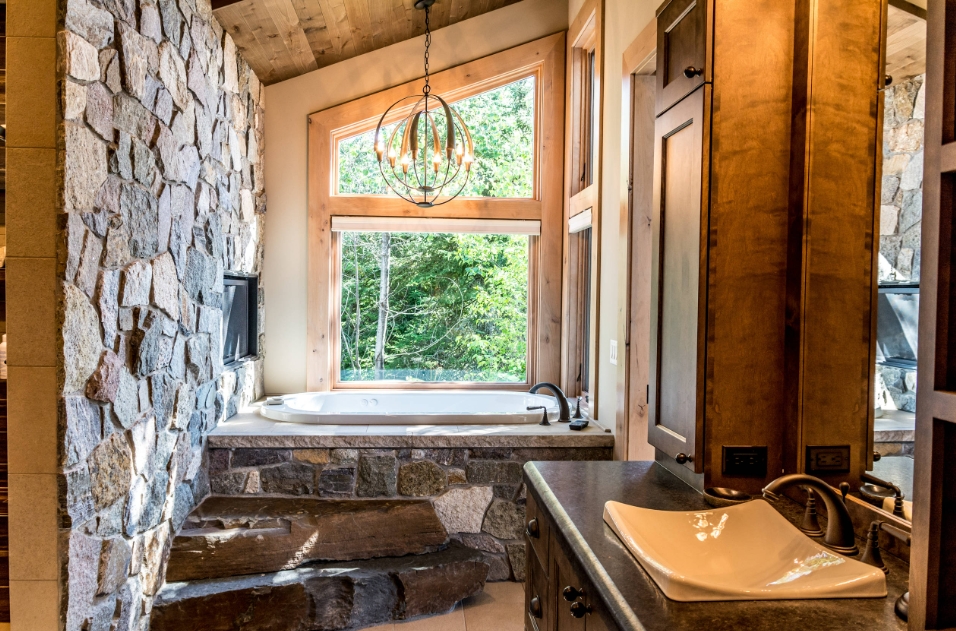
Stones have a distinct texture that can be rough or smooth, according to how they are processed. For this North Shore Lake home, the builders chose to use rough hewn stone to line the walls and create a surround for the bathtub. Stone steps lead up to the bathtub and integrate seamlessly with the stone wall. The rugged stone complements the wood tones, creating a harmony in interior elements that can be found outdoors. The large surrounding windows allow in ample natural light that enhances the depth and character of the stones.
Mt. Tamalpais Contemporary Bathroom
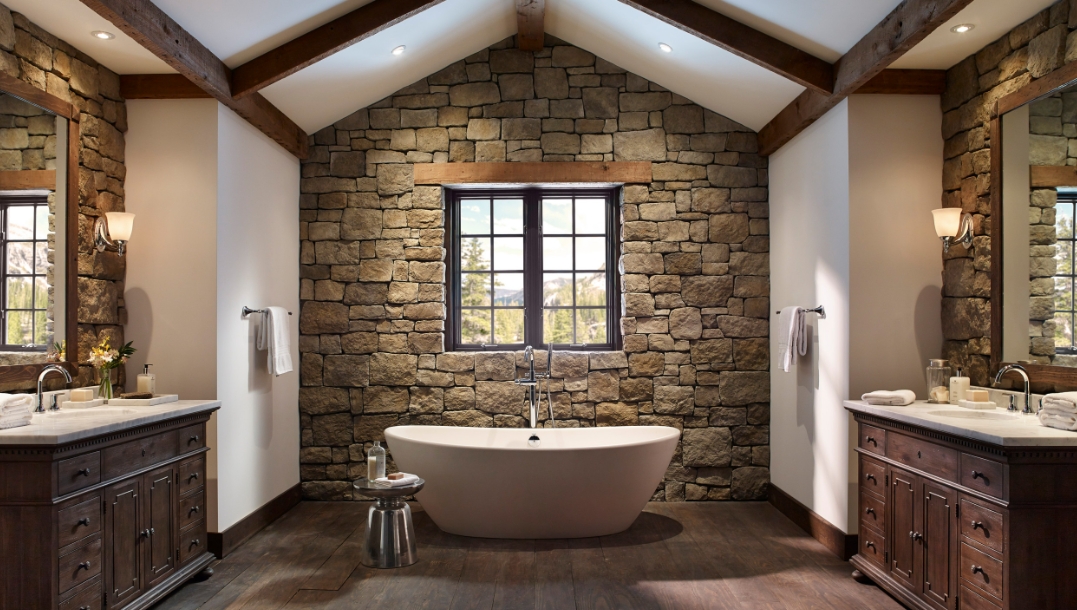
The shower wall in this contemporary bathroom is made of sleek, horizontal stone in a warm white color that complements the bathroom’s clean and minimalist design.
The stone’s neutral color, narrow shape, and tight layout add subtle texture to the bathroom without adding more color or complicating the design. The use of this type of stone enhances the space’s contemporary aesthetic while also creating a strong connection to the natural world, which plays such a vital role in a home situated in this type of outdoor environment.
Rustic Cabin Bathroom
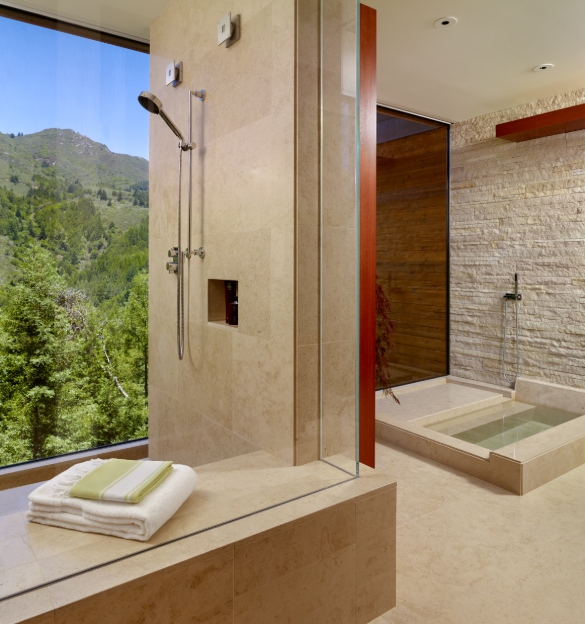
The stone wall in this bathroom is immediately noticeable, with rough, naturally beautiful stones surrounded by crisp, white walls. The stone’s organic shape and rough texture give the clean-lined bathroom an organic appeal that is comfortable but bold. The stone accent walls anchor the bathroom’s design, giving it a look of durability and a timeless aesthetic while also increasing its practical appeal.
Transitional Bathroom
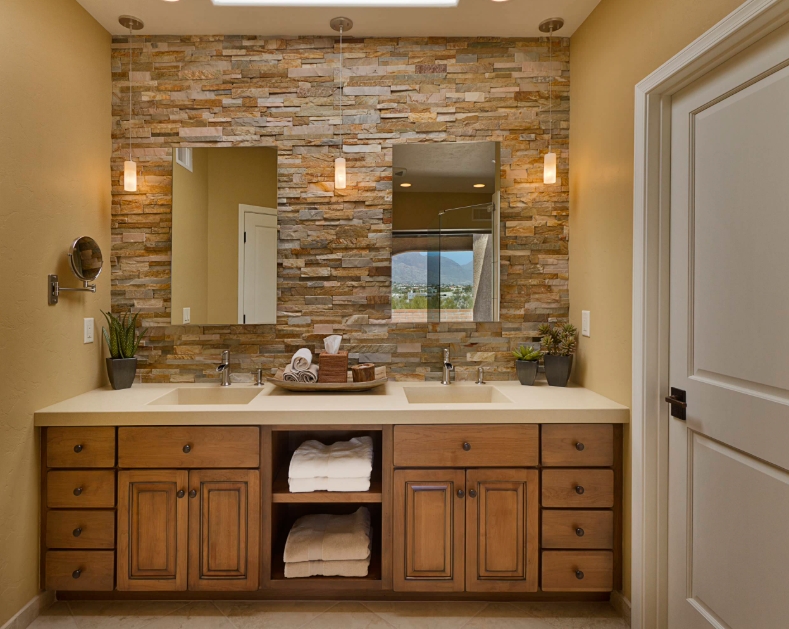
The stone wall in this transitional bathroom serves as a striking centerpiece behind the central vanity and mirrors. Framing the mirrors against this surface enhances their simple shape. The rich texture and organic variation of the stone contrast effectively with the smooth surfaces of the counter and mirrors, adding depth and character to the design. The variegated colors of the stone blend seamlessly with the warm wood and paint color.
Cool Contemporary Bathroom
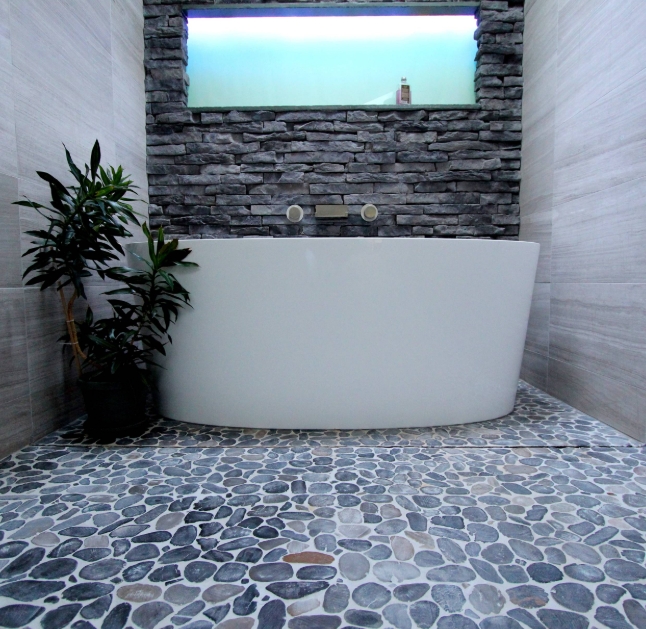
The majority of stones used on bathroom walls have a warm color tone. Gray stones are also ideal for bathrooms, particularly in bathrooms where you want to cool down the warmth of the space.
The nubby, dark gray stacked stone stands in contrast to the rounded river rock on the floor and the smooth tiled walls. Together, they provide an excellent backdrop for the freestanding tub. The combination of these materials is an effective way to give your bathroom a natural but contemporary style.
Refined Rustic Bathroom
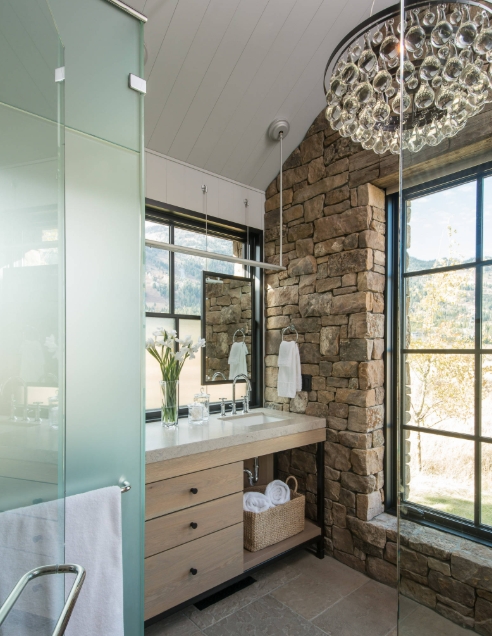
This Tetons bathroom combines rustic and refined elements into a single cohesive style, resulting in an elegant yet grounded look. The most prominent visual element is the stone wall perpendicular to the vanity. The rough hewn stone of the wall contrasts with the smooth textures of the vanity, chandelier, and glass-enclosed shower. The difference in these surfaces creates more visual and design interest because it has elements of the unexpected.
Rustic Contemporary Bathroom
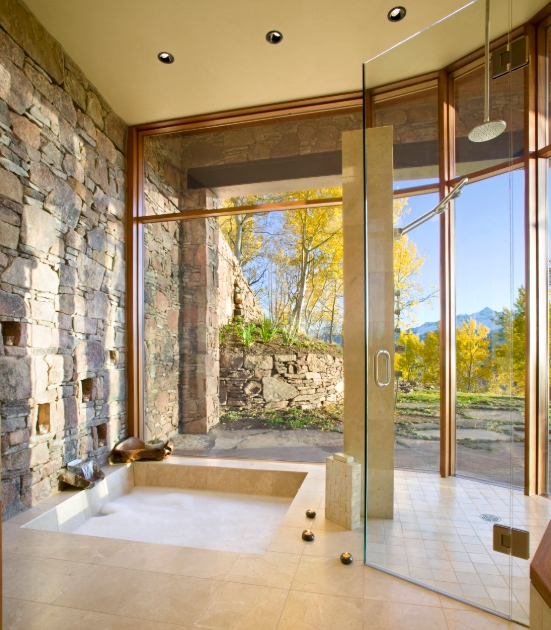
This bathroom has an impressive stone wall that seamlessly connects the interior and exterior, creating a visual and physical connection between the spaces. The outdoor stone wall and the surrounding woods complement the warm hues and rugged texture of the variegated stones on the bathroom wall.
The consistency of the colors and materials contributes to the bathroom’s organic modern aesthetic. The rugged qualities of the stones contrast well with the sleek interior finishes, such as floor-to-ceiling windows and simple chrome fixtures.
Spa Bathroom
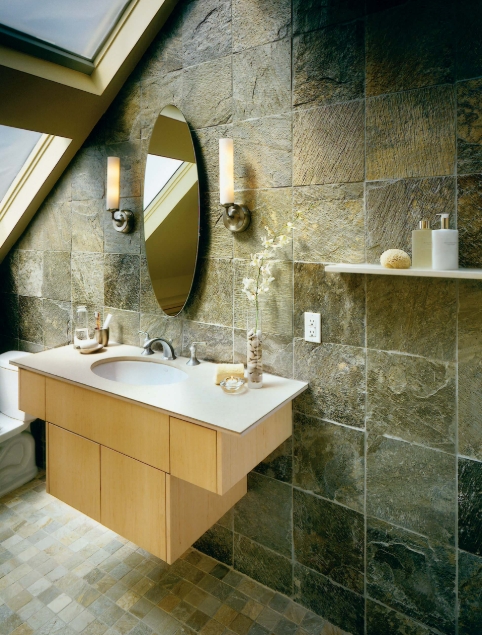
This bathroom uses natural stone slate tiles to cover the walls and floor to create an enveloping look. The rich, textured surface of slate introduces an earthy element to this otherwise sleek bathroom design. It provides an excellent contrast to the natural wood, wall-hung cabinets, and single wall shelf.
The muted gray-brown of the slate creates a calm, neutral color palette that makes the bathroom feel peaceful and serene. Slate is also a resilient surface that makes any bathroom more functional and long-lasting.
Rustic Victorian Bathroom
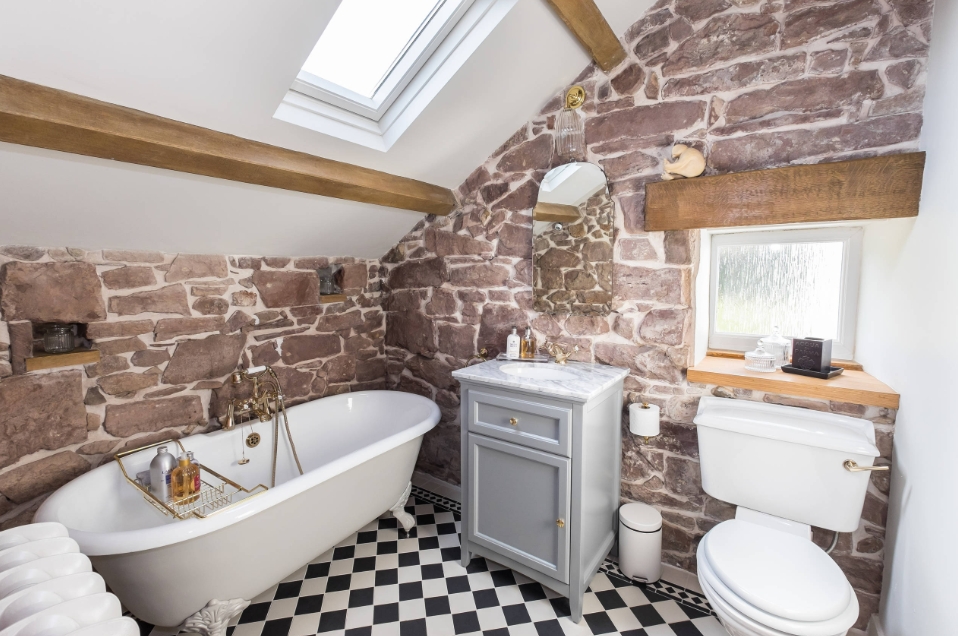
This bathroom combines vintage charm with the rustic appearance of natural stone. The red sandstone walls are the most visible feature of the bathroom, adding character and anchoring the design. The designer chose to contrast these walls with Victorian elements such as the clawfoot tub and black and white tile floor.
The combination of natural materials and intricate classic accents gives this bathroom a distinct appearance. This fusion of rustic and Victorian elements results in a timeless and inviting space that is both luxurious and nostalgic.
Asian-Style Bathroom
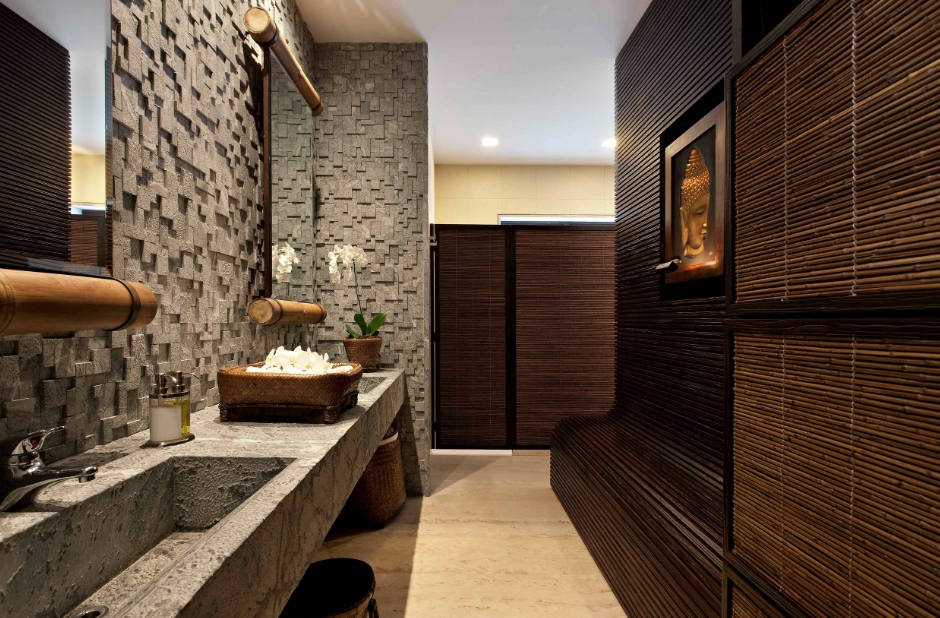
This Asian-style bathroom makes use of mosaic gray stone to stunning effect. It effectively enhances the spa-like and natural qualities of the bathroom. The stone basin-style sinks are integrated into the gray stone backsplash to give the impression of a natural formation. Without overpowering the bathroom with color, the mosaic stone arrangement adds depth and visual interest. Gray complements the wood tones and balances the warmth of the dark wood.
Organic Contemporary Bathroom
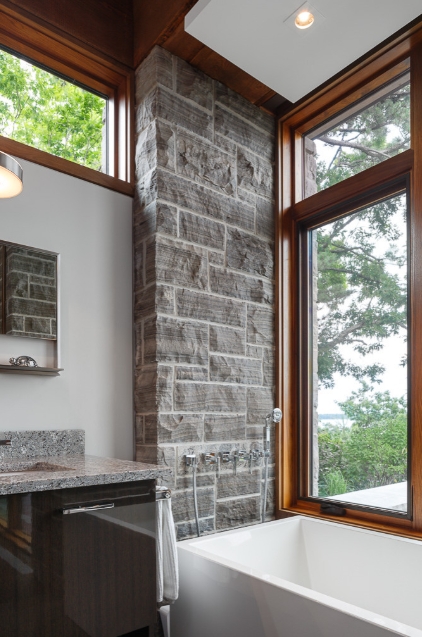
In this contemporary-style bathroom, the geometric regularity of the stone on the stone wall complements the design’s spare, straight lines. The clean, uniform appearance of the stones adds order and consistency, perfectly aligning with the vanity, bathtub, windows, and fixtures. This strong sense of clean symmetry reinforces the contemporary style, but the stone and wood accents add organic qualities to the bathroom, giving it more warmth and textural depth.
The post Stylish and Classic Designs for a Bathroom with Stone Walls appeared first on Homedit.
Mold and mildew thrive in damp, dark environments. Bathrooms, especially those that lack proper ventilation, are some of the most humid spaces in the house, offering prime growing conditions for mold or mildew to develop.
While it’s common to find mildew spots on the bathroom ceiling, wet towels thrown in a pile on the floor are just as likely to be the source of a bad smell. If your bathroom smells damp and musty 24/7, you need to eliminate the source of the problem to get rid of the odor. Here’s how.
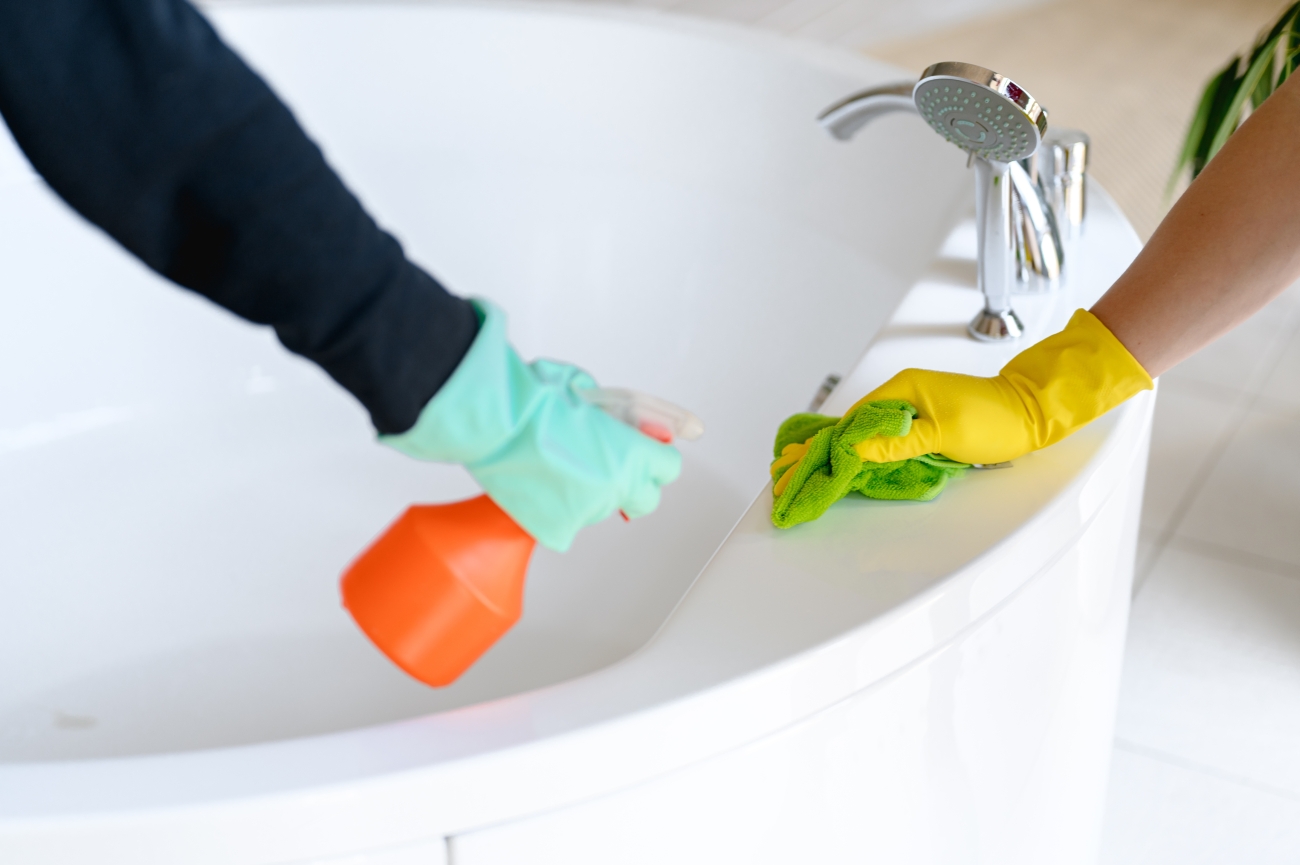
Locate the Source of the Problem
Mildew can appear in white, gray, or green spots. It’s usually flat in its early stages but can have a fluffier appearance as it ages.
Common places to find mildew in the bathroom include on the bathroom ceiling or walls near the shower, on the caulk lines in the shower or bathtub, and on any damp rugs or towels.
Kill the Mildew
Once you’ve found the mildew, you need to kill it so that it doesn’t continue to spread. You can remove mildew from the ceiling, walls, caulk lines, and bathtub or shower surround with a mixture of one part bleach to three parts water. Spray the solution on the mildew and let it sit for ten minutes. Then, use a soft-bristled scrub brush to scrub the mildew from the area. Finally, go back over the treated spots with a wet towel to rinse.
Whether or not you’ll be able to rid your towels, bath mats, and shower curtains of their mildew smell depends on the severity. We recommend you wash everything using your washing machine’s hottest cycle and regular detergent. (You can even wash your shower curtain liner in the washing machine—just don’t put it in the dryer.)
If regular detergent doesn’t rid your items of the mildew, rewash them, this time adding 1 cup of white distilled vinegar to the washing machine instead of your regular detergent.
Replace or Clean Your Bathroom’s Vent Fan
A lack of ventilation is the number one reason that bathrooms develop mold and mildew. When you take a hot shower, the steam needs somewhere to escape, or else it will coat your bathroom ceiling, creating a moist environment for fungi and leading to the possible rot of your drywall ceilings.
If you don’t have a bathroom vent fan or yours doesn’t work, install one as soon as possible. If you currently have a bathroom vent fan but are still dealing with mildew problems, ensure that the fan is appropriately exhausting the excess moisture. First, check if the fan’s vents are clogged with dust. If so, clean your exhaust fan. If the fan isn’t dirty, it’s likely not big or powerful enough for the space.
Deep Clean the Bathroom
As a final step, deep clean your bathroom. Launder any soft materials that you haven’t already washed. Then, wash the ceilings and walls, wipe down the counters and mirrors, clean the toilets, scrub the shower or tub, and sweep and mop.
Deep clean your bathroom every couple of weeks to keep it in tip-top shape.
The post How to Get Rid of a Mildew Smell in the Bathroom for Good appeared first on Homedit.
Nobody looks forward to cleaning the toilet. However, it should be cleaned every week for the obvious reasons and to prevent mold growth. Mold spores are everywhere. They grow and thrive in wet or humid locations where there is an organic source of food. Bathrooms–especially toilets–provide everything mold requires. Especially if it is not cleaned regularly.
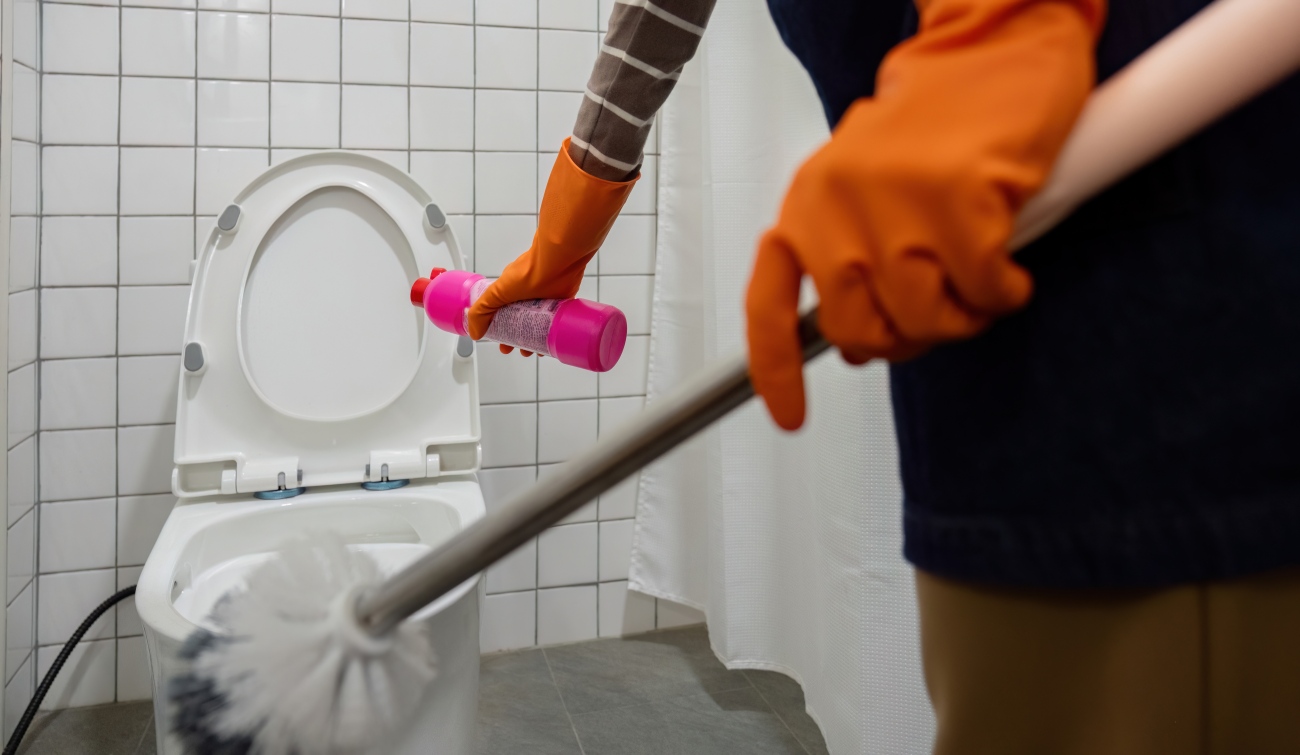
The Importance Of Cleaning Mold
Mold growth is not only unsightly, but it is also unhealthy. Mold releases spores that can cause allergic reactions and breathing problems. Some types of mold release mycotoxins that are toxic to humans and could produce some of the following reactions.
- Sneezing.
- Runny or Stuffy Nose.
- Cough and Post-nasal Drip.
- Itchy Eyes, Nose, and Throat.
- Dry Scaly Skin.
- Severe Asthma Attacks. Coughing, wheezing, shortness of breath, chest tightness.
3 Ways To Clean Mold From a Toilet Base
The most likely location for mold to grow on a toilet base is in the bowl. Don’t ignore the outside–especially where it sets on the floor. Condensation, urine, and water leaks combined with dirt grow mold. If mold persists at floor level, your subfloor may be the culprit. A leak from the base of the toilet soaks the subfloor, causing mold and rot to spread. Subfloor damage usually leads to a time-consuming and sometimes expensive repair.
Bleach
Bleach removes surface mold from non-porous material like porcelain. It will not lift mold out of porous material like wood.
- Mix 4 teaspoons of bleach in a quart of room-temperature water. Or follow label directions. (Some bleach is stronger than others.)
- Spray the mixture liberally on moldy areas.
- Let it work for about 15 minutes.
- Scrub off the mold with a soft bristle brush.
- Rinse and dry thoroughly.
Vinegar and Baking Soda
Vinegar and baking soda can be used in two ways. Mix up a paste and spread it on the moldy sections of the toilet base. Or sprinkle dry baking soda on moldy areas, then spray with undiluted vinegar. The paste sticks on sloped surfaces better than dry baking soda.
- Mix two parts baking soda with one part vinegar into a thick paste. (8 tbsps of baking soda and 4 tbsps of vinegar cover approximately one square foot.)
- Spread the paste about ¼” thick on moldy areas.
- Let sit and dry for about one hour.
- Scrub off the dried paste and mold.
- Flush the remains inside the bowl and vacuum up the flakes outside the bowl.
- Wipe with a microfiber cloth dampened with vinegar to remove any remaining paste and help deter future mold growth.
Hydrogen Peroxide
- Mix hydrogen peroxide and water 50/50 in a spray bottle.
- Spray the entire base–inside and outside–with the solution.
- Let it work for about 15 minutes.
- Scrub with a soft bristle brush or microfiber cloth.
- Rinse and dry well with another microfiber cloth.
End Notes
Other than baking soda and vinegar, do not mix any of the three cleaners together. Hydrogen peroxide and vinegar create a toxic chemical reaction harmful to skin, eyes, throat, and lungs. Hydrogen peroxide mixed with bleach can cause an explosion.
The post How To Clean Mold From a Toilet Base appeared first on Homedit.
20 Jan, 2025 | Admin | No Comments
Moera CF Senegalese Animator, Illustrator, Storyboard Artist and Character Artist
Moera, a talented French artist based in London, is making waves in the world of animation and illustration. A 2011 graduate of the renowned EMCA animation school, Moera has built an impressive career as a Creative Director, 2D Animator, Character Designer, Storyboard Artist, and Illustrator. His work is a testament to the power of storytelling […]
16 Jan, 2025 | Admin | No Comments
Jonathan Djob Nkondo: The Animator Redefining Surreal Storytelling
Jonathan Djob Nkondo is an acclaimed animator and illustrator whose work defies convention, blending surrealism, sharp social commentary, and a unique visual style. Based in Paris, Nkondo has made a name for himself as a bold and innovative artist, creating animated shorts, illustrations, and digital art that push the boundaries of traditional storytelling. A Distinct […]
An average bathroom renovation increases a home’s resale value by more than the original cost. Beware of including some trendy expensive items that are not worth spending money on and may fall out of style. Many of them do not recoup the initial cost. Avoid overspending on these additions.
Steam Showers
Steam showers may be one of those expensive fads that lose their appeal. Especially at an installation price of around $12,000.00 They use less water than a shower but require more electricity to operate properly. Steam showers do not provide a decent return on investment when you sell the house.
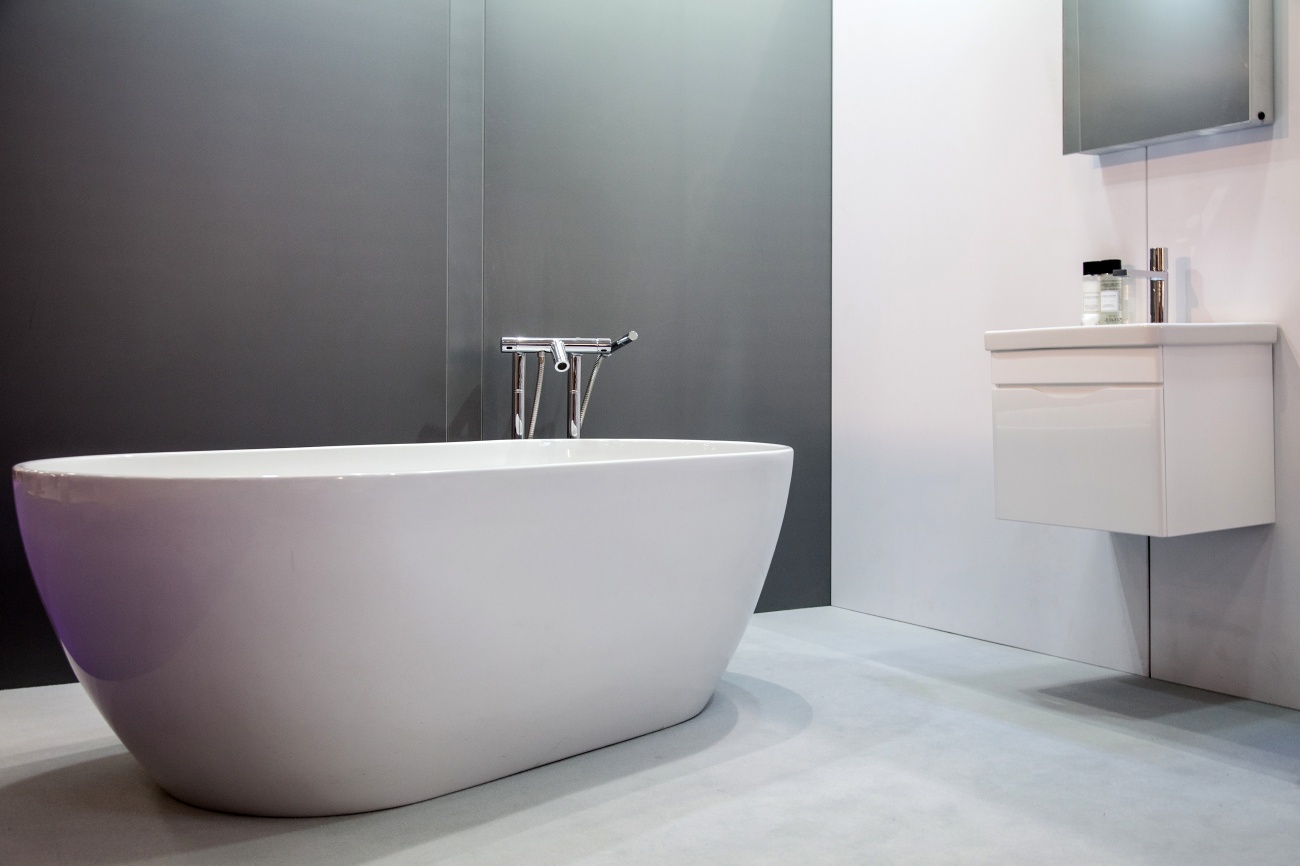
Stand-Alone Bathtubs
Free-standing bathtubs are a great design feature in a bathroom that has enough space. But many people do not bathe often–making a fancy stand-alone tub a waste of money. If you don’t use the bathtub very much, opt for a tub/shower combination that provides for your needs. A basic tub costs $700.00. A luxury tub may cost up to $3000.00.
Whirlpool Tubs
Whirlpool tubs cost up to $35,000.00 to install. You will never recover that investment. It costs more money to operate and requires more maintenance. Repairs for pumps and electrical components are expensive and messy.
High Tech Niche Products
All of these techy niche products are unnecessary. You can use the bathroom for its designed functions without any of them. The installation costs add up quickly and the more toys you have, the more electricity you use. Much of the technology is far from problem-free and costs money to repair or replace.
- Motion-Activated Faucets.
- Motion-Activated Soap Dispensers.
- Self-Flushing Toilets.
- Self-Cleaning Toilets.
- Smart Mirrors.
- Smart Glass.
- Smart Lights.
- Smart Showers.
- Smart Tubs.
- Toilet Bowl Lights.
- Heated Towel Racks.
- And the List Goes On.

Marble Floors
Marble floors are beautiful. Marble is also porous and absorbs water and stains easily if not resealed regularly. It needs resealing every 3 -6 months–turning marble floors into a constant maintenance job. Porcelain or ceramic tiles are approximately one-quarter of the cost of marble, require little maintenance, and can be made to look very attractive.
Tiles Everywhere
Installing tiles outside the shower or tub enclosure is a waste of money. Tile is much more expensive than a good paint job and the grout is more difficult to clean. Not cleaning tile grout can lead to mold growth which is unhealthy and makes the room look uncared for.
Heated Flooring
Installing heated bathroom flooring costs up to $20.00 per square foot not including tiles. Maintenance costs can be expensive and you will never recover the installation cost on resale.
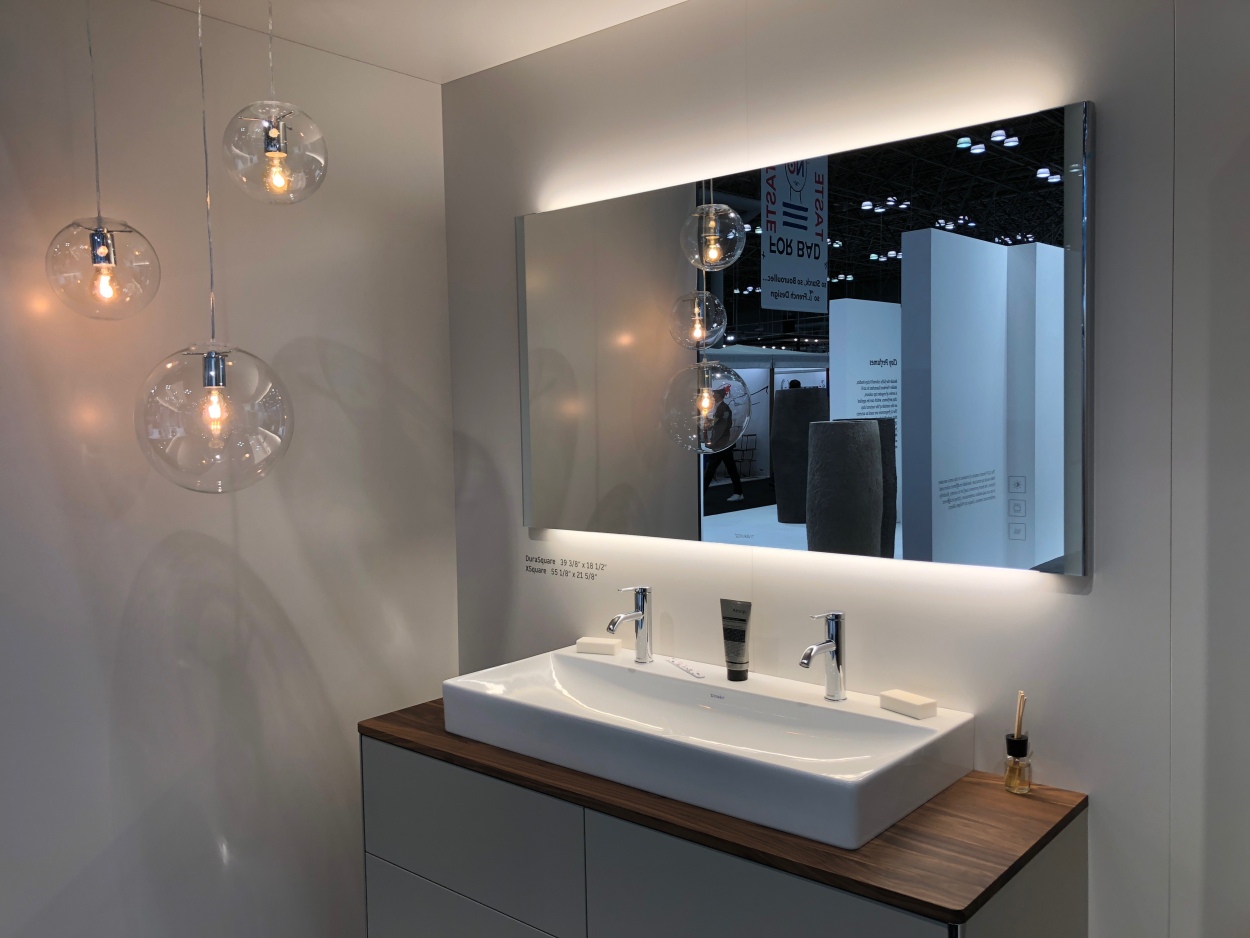
Fancy Light Fixtures
Fancy light fixtures look very attractive, usually provide inferior lighting, and do not pay back their investment. Some light fixtures look totally out of place in bathrooms. Bright lighting with a dimmer switch is a better option for much less expense.
The post Things In Your Bathroom That Aren’t Worth Spending Money On appeared first on Homedit.
Representation matters more than ever in the world of 3D art and gaming. Ignacio Kaliman, a talented 3D artist, has taken significant strides to enhance African representation through his stunning study of a woman from the Nuer Tribe of South Sudan. This article explores Kaliman’s artistic process, the importance of African representation in games and […]